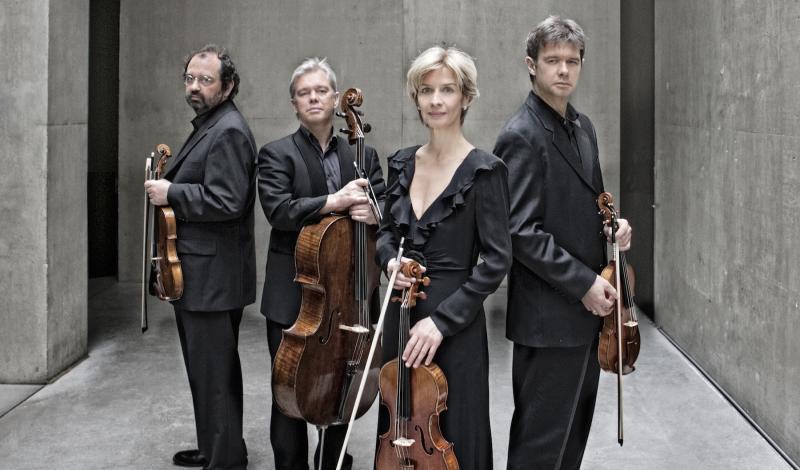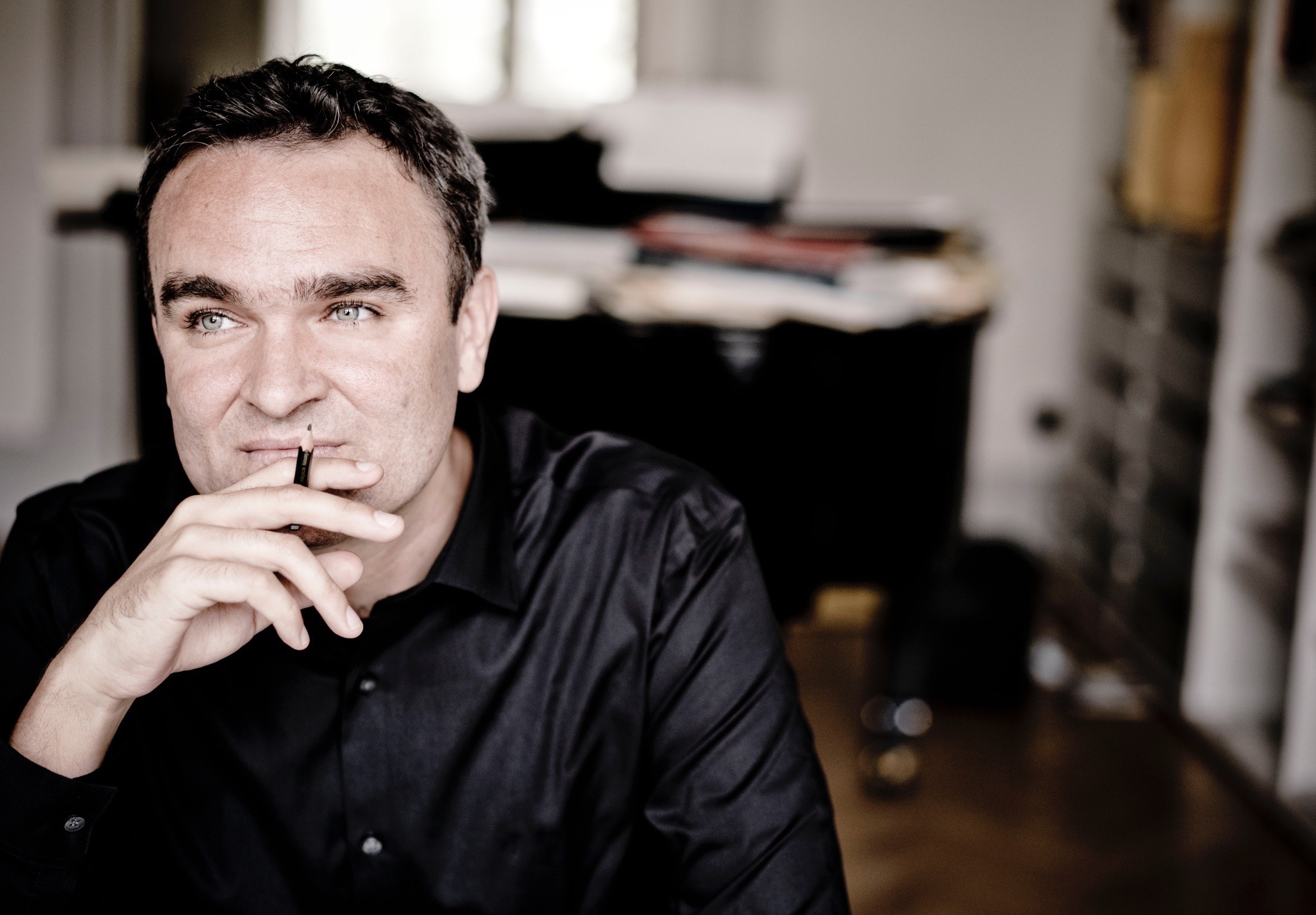Hagen Quartet, Jörg Widmann, Wigmore Hall review – proportion and elegance | reviews, news & interviews
Hagen Quartet, Jörg Widmann, Wigmore Hall review – proportion and elegance
Hagen Quartet, Jörg Widmann, Wigmore Hall review – proportion and elegance
Widmann’s new quintet a study in reserve and intimacy

Jörg Widmann writes fast. He is also one of the few young German composers who can write distinctive and idiomatic music without feeling the weight of his country’s musical heritage on his shoulders at every turn. Surprisingly, then, his Clarinet Quintet, which here received its UK premiere at Wigmore Hall, was eight years in the making, and was initially abandoned because "music history ...
Widmann (pictured below by Marco Borggreve) credits that change of heart to the Hagen Quartet, with whom he played this evening, and they are certainly a good match. His music is often quiet, relying on muted harmonies and soft but richly shaded sonorities – the very qualities that make the Hagen sound special. There is plenty more here, too, from extended bowing techniques to clarinet multiphonics, but the Hagens took it all in their stride.
The work is a 40-minute Lento, and there is a feeling throughout of suppressed Romantic expression, as if the music continually wants to shift up a gear or launch into a searing climax. The climaxes, when they do come, are either frustrated by the slow tempo or interrupted before they begin. And the rest of the music hovers around silence, relying on the clarinet’s ability to play at the edge of audibility. At one point, the pitches disappear altogether, and Widmann simply blows air through his clarinet while the strings bow the bodies of their instruments. From there, the music gradually returns, but always seems on the verge of disappearing again at any minute.
On top of all this, Widmann adds a big, Romantic melody. The disjunction between avant-garde and romantic would jar in lesser hands, but Widmann gets the balance just right. The melody always appears over ambiguous harmonies, or even unpitched sounds, and is only ever present for an instant before melting back into the textures. There’s no apparent irony here, nor any knowing reference back to the Romantic era – he plays it straight, and somehow gets away with it, even if he’s right on the edge of good taste. As if to emphasise that Widmann does indeed speak from within the Austro-German tradition, the Hagen Quartet prefaced his work with the Webern String Quartet of 1905. Like the Widmann, this plays out as a single slow span (though it is actually three movements run together), melodically rich, but always supported by dark, nebulous harmonies. This, too, is perfect music for the Hagen Quartet, who infuse every minute gesture with meaning and expression through the elegance of their dark, burnished tone.
As if to emphasise that Widmann does indeed speak from within the Austro-German tradition, the Hagen Quartet prefaced his work with the Webern String Quartet of 1905. Like the Widmann, this plays out as a single slow span (though it is actually three movements run together), melodically rich, but always supported by dark, nebulous harmonies. This, too, is perfect music for the Hagen Quartet, who infuse every minute gesture with meaning and expression through the elegance of their dark, burnished tone.
Mozart, however, calls for a brighter sound, and for his Clarinet Quintet in the second half, Widmann and the Hagens moved towards a more straightforward, classical tone. Even so, the playing was still reserved, with generally steady tempos and quiet dynamics, which served to highlight the intimacy and playfulness of this music. Widmann performed very much as part of the ensemble, with little ostentation, no vibrato, and modest, if sometimes quirky ornaments. Mozart’s writing for the string ensemble here is unusually democratic, with many exposed moments for the viola and cello, with whom Widmann would closely interact – lots of eye contact from him, and rarely a glance at the music. There were a few surprising moments, like the last slow episode of the finale, before the coda, which was brought to almost to a standstill while the players luxuriated in the open, airy textures. But on the whole, this was a measured and disciplined reading. Some may have found it overly mannered or lacking in expression, but to me it was the very model of classical proportion and elegance.
rating
Explore topics
Share this article
The future of Arts Journalism
You can stop theartsdesk.com closing!
We urgently need financing to survive. Our fundraising drive has thus far raised £33,000 but we need to reach £100,000 or we will be forced to close. Please contribute here: https://gofund.me/c3f6033d
And if you can forward this information to anyone who might assist, we’d be grateful.

Subscribe to theartsdesk.com
Thank you for continuing to read our work on theartsdesk.com. For unlimited access to every article in its entirety, including our archive of more than 15,000 pieces, we're asking for £5 per month or £40 per year. We feel it's a very good deal, and hope you do too.
To take a subscription now simply click here.
And if you're looking for that extra gift for a friend or family member, why not treat them to a theartsdesk.com gift subscription?
more Classical music
 Rajakesar, Selaocoe, The Hermes Experiment, Wigmore Hall review - a joyful, fascinating laboratory of noise
Celebrating the avant-garde through different cultures
Rajakesar, Selaocoe, The Hermes Experiment, Wigmore Hall review - a joyful, fascinating laboratory of noise
Celebrating the avant-garde through different cultures
 Classical CDs: Vitamins, kings and magic spells
A neglected ballet score, romantic piano concertos and contemporary British music
Classical CDs: Vitamins, kings and magic spells
A neglected ballet score, romantic piano concertos and contemporary British music
 Kavakos, Philharmonia, Blomstedt, RFH review - a supreme valediction forbidding mourning
Nonagenarian conductor provides the flow, his players the passion, in Mahler's Ninth
Kavakos, Philharmonia, Blomstedt, RFH review - a supreme valediction forbidding mourning
Nonagenarian conductor provides the flow, his players the passion, in Mahler's Ninth
 Perianes, Orchestre Symphonique de Montréal, Payare, Barbican review - elegance and drama but not enough bite
Often dynamic Venezuelan conductor misses the darkness of the 'Symphonie fantastique'
Perianes, Orchestre Symphonique de Montréal, Payare, Barbican review - elegance and drama but not enough bite
Often dynamic Venezuelan conductor misses the darkness of the 'Symphonie fantastique'
 La Serenissima, Wigmore Hall review - an Italian menu to savour
Tasty Baroque discoveries, tastefully delivered
La Serenissima, Wigmore Hall review - an Italian menu to savour
Tasty Baroque discoveries, tastefully delivered
 Roman Rabinovich, Wigmore Hall review - full tone in four styles
Fascinating Haydn, Debussy and Schumann, odd Beethoven
Roman Rabinovich, Wigmore Hall review - full tone in four styles
Fascinating Haydn, Debussy and Schumann, odd Beethoven
 Wyn, Dwyer, McAteer, RSNO & Choirs, Diakun, Usher Hall, Edinburgh review - ebullient but bitty
‘Carmina Burana’ is fun in parts, but Langer’s ‘Dong’ doesn’t flow
Wyn, Dwyer, McAteer, RSNO & Choirs, Diakun, Usher Hall, Edinburgh review - ebullient but bitty
‘Carmina Burana’ is fun in parts, but Langer’s ‘Dong’ doesn’t flow
 Gerhardt, BBC Philharmonic, Chauhan, Bridgewater Hall, Manchester review - from grief to peace
Anna Clyne, Shostakovich and Richard Strauss tell us about loss, struggle and healing
Gerhardt, BBC Philharmonic, Chauhan, Bridgewater Hall, Manchester review - from grief to peace
Anna Clyne, Shostakovich and Richard Strauss tell us about loss, struggle and healing
 First Person: Alec Frank-Gemmill on reasons for another recording of the Mozart horn concertos
On ignoring the composer's 'Basta, basta!' above the part for the original soloist
First Person: Alec Frank-Gemmill on reasons for another recording of the Mozart horn concertos
On ignoring the composer's 'Basta, basta!' above the part for the original soloist
 Mailley-Smith, Piccadilly Sinfonietta, St Mary-le-Strand review - music in a resurgent venue
Neglected London church now the home of a vibrant concert series
Mailley-Smith, Piccadilly Sinfonietta, St Mary-le-Strand review - music in a resurgent venue
Neglected London church now the home of a vibrant concert series

Add comment